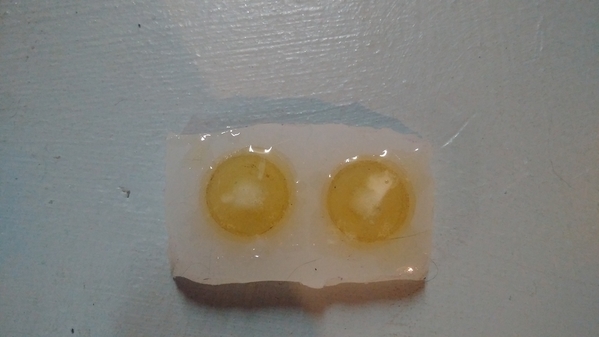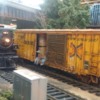So with all the unit coal, oil tank, Intermodal, and grain how's everyone 2 railing thier MTH and Lionel trains? What's the most cost-effective, easiest, operationally most effective way of doing it? I have many 25-50 car unit trains to 2 rail yet. Any thoughts would be appreciated. Thanks so much!
Replies sorted oldest to newest
When you install the MTH 2 rail trucks on to their cars, it lowers the height. That worked well on some of the cars I did. I also just swapped out wheels on certain ones. I tried several routes like K-line trucks, Weaver, and other brands. On the Lionel modern trucks with spinners, I ordered a bulk quantity from NWSL to just swap out the axle sets. I sold off 1/3 of them and of course I later regretted it.
Protocraft had a great modern RB 2 rail truck that I put on my Atlas stack well car sets. They roll fantastic. The next order is all proto 48 stuff. Maybe if he gets enough interest, he would considering ordering more O gauge 2 rail.
Engineer-Joe posted:Protocraft had a great modern RB 2 rail truck that I put on my Atlas stack well car sets. They roll fantastic. The next order is all proto 48 stuff. Maybe if he gets enough interest, he would considering ordering more O gauge 2 rail.
Thanks Joe that helps and NWSL was my fall back plan...they are rollingup the carpet for orders this summer though. I'm actively working with them on magic carpet drives...might have to add trucks. Do the 2 rail MTH trucks seem worth it? Thanks! Anyone else?
The MTH 2 rail trucks roll very well. That's big with me and what I look for the most running long trains. They have a large fixed bearing cover over them and I think that's modeling an older truck style? I prefer a more modern version with spinning caps and real bearings when possible. The cost jumps up exponentially.
The MTH 2 rail trucks have a lowered center bolster than their 3 rail version. So it lowers their cars and makes them look better to me. The wheels track very well and a long string of cars are very easy and dependable to pull. Probably one of the best deals out there for large number conversions. I like the newer Atlas trucks now for their looks and the way they roll. I had several older ones that crumbled or rolled poorly and that clouded my judgement.
I went with so many different trucks in the beginning as I got them easily from different people. Several of them are gone now. I don't see many older K-line and Weaver diecast versions around. Lionel introduced their 2 rail kits, and I haven't got any yet. I would also like to try the Intermountain versions still. When I started, I would just use the wheel sets in the stock trucks. That wasn't the best for getting the ride height correct.
I was influenced by the work of Ed R., Mike P. and others here, when I started. I have always watched your work and been a big fan.
On the newer MTH cars, they have Kadee mounts that will have the car about 1/8" too high on the hi-rail trucks (if you can get the couplers off without hacking them to bits), but will be at the right height with the MTH 2-rail trucks in place. A simple solution. On the older MTH cars, you have to do some drilling and use shims, though the MTH 2-rail trucks will still work. I'm looking at that for a couple of six-car sets.
The exceptions are the older Auto Racks and Center Beam flat cars, which need to have the trucks relocated (I've posted on these elsewhere). In those cases, since you have to modify the chassis, you might as well notch the end sills to properly locate the couplers. The modern cars have the couplers mounted BELOW the end sills which is incorrect, but you can probably live with it operationally. I got some kind of rivet-counting infection that would make me want to correct that.
I've converted all of my Weaver tank cars to 2-rail by removing the coupler arms and installing Intermountain wheel sets. I'm lazy, so the Atlas cars will just get truck swaps and Kadees or Atlas couplers added, depending on the car.
The switch is in progress for the fleet I plan to retain. What's fun is that the equipment works for the most part on the club 3-rail layout so I don't lose any enjoyment of operation as my YouTube channel bears out.
I use Athearn trucks with Intermountain wheelsets. If you are converting several identical models, then you can work out the system on one car and replicate it for the others to keep the cars at the right height. I also install KD couplers and draft boxes, shimming them if necessary. Otherwise, it's a matter of working on each car separately until you get it right. I generally use a 4-40 screw (or machine screw) with the head turned down to a smaller diameter to hold the Athearn truck in place.
B Smith posted:I use Athearn trucks with Intermountain wheelsets. If you are converting several identical models, then you can work out the system on one car and replicate it for the others to keep the cars at the right height. I also install KD couplers and draft boxes, shimming them if necessary. Otherwise, it's a matter of working on each car separately until you get it right. I generally use a 4-40 screw (or machine screw) with the head turned down to a smaller diameter to hold the Athearn truck in place.
I wish Athearn produced 70-ton and 100-ton roller bearing trucks for more modern equipment (and I wish Intermountain produced 36" wheels). I like how they're sprung and equalized and they tend to track well.
I've converted a bunch of Lionel scale cars to 2 rail using both NWSL and intermountain wheels. The most important part is to gauge the wheels with an NMRA gauge and also go over your track, including turnouts with the track gauge.
The wheels as delivered may be slightly off and it makes a difference.
Protocraft. Still waking for 70T trucks.
I'm planning on having a bunch of 33", 36" and 38" .115 fine scale insulated wheels made. Need to talk to folks at OSW regarding axles to see if a standard axle is possible that can be used for both Ow5 and P48 gauging at least in diameters if not lengths.
I use, almost entirely, the truck side frames that were made by Athearn or Weaver Models. These were acquired over a period of years, most without wheels and axles. With almost 425 freight cars on the layout, some beginning life as 2 or 3 rail, I was left with a challenge in converting the 3 rail pieces. I filled this void by casting my own wheels. I started with an original set of 2 rail plastic wheels. I pulled the wheels off the axles and made a rubber mold of them, ( I have made 2 molds, a 4 wheel mold and a 2 wheel mold shown.). After the casting resin drys, within half an hour, I remove them from the mold then cut a length of drill rod and sharpen the axle points. I press on the cast wheels and gauge them. They fit tight enough that gluing is not required. On 3 rail cars I also replace the original bolster system with a cast set I created the same way as above. Metal wheels would definitely be the choice, but for now these work just like the original plastic sets. 




Attachments
Myles, some great ingenuity on your part.
Dan Weinhold
Thanks Dan...I've been doing all kinds of molding of different things I need lots of ......barrels, boxes, walls even!y caboose and freight car sides, ends ,floors etc that are out of production or scratch built like this coal train i've been working on. This one still needs end platform brake details etc. 
Attachments
Myles, seems like you'd be a prime candidate to try 3D printing!
Dan Weinhold










